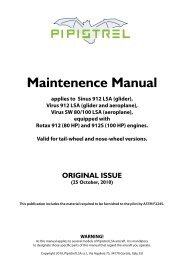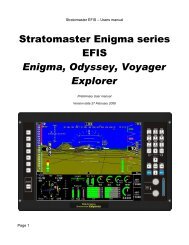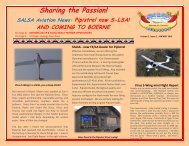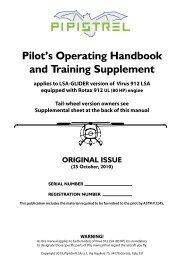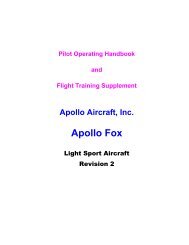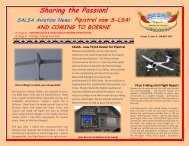Pipistrel Virus Aircraft Operating Instruction - Salsa Aviation
Pipistrel Virus Aircraft Operating Instruction - Salsa Aviation
Pipistrel Virus Aircraft Operating Instruction - Salsa Aviation
Create successful ePaper yourself
Turn your PDF publications into a flip-book with our unique Google optimized e-Paper software.
AIRCRAFT OPERATING INSTRUCTIONS – VIRUS 912 S-LSA GLIDERYou might say: “Why did they not keep their speed within safe limits? How could they be so thoughtlessto afford themselves exceeding the V NE ?” Speaking with the two pilots they both confessed they wentover the line inadvertently. “Everything just happened so suddenly!” was what they both said. Thereforeit is of vital importance to be familiar to all factors that might influence your flying to the point ofaccidentally exceeding the V NE .Here is the relationship between the human factor and performance: The human body is not intendedto be travelling at 250 km/h (135 kts), nor is it built to fly. Therefore, in flight, the human body and itssignals should not be trusted. To determine the speed at which you are travelling, one normally reliesupon two senses – the hearing and sight. The faster the objects around are passing by, the faster one istravelling. True enough. The louder the noise caused by air rushing past the airframe, the faster onemust be cruising. True again. But let us confine ourselves to the scenarios associated with both of theseevents. At higher altitudes, human eye loses its ability to determine the speed of movement precisely.Because of that pilots, who are flying high up feel like they are flying very slowly. Additionally, it seemsthat at high speeds the air rushing past the airframe ought to cause a tremendous rushing noise. But thisis wrong! In fact, rushing air noise is caused by drag. Modern aircraft like Sinus and <strong>Virus</strong>, manufacturedof composite materials, have so little drag in cruise attitude, that they actually sound quieter than youwould expect. Especially if you are used to wearing a headset when flying you must not rely on your earas the instrument for determining speed. REMEMBER! When flying high, the only reliable tool todetermine airspeed is the cockpit instrument - the airspeed indicator!How to read and understand what the airspeed indicator tells you?Let us first familiarize with the terms used below:IAS: stands for Indicated Airspeed. This is the speed the airspeed indicator reads.CAS: stands for Calibrated Airspeed. This is IAS corrected by the factor of aircraft’s attitude. No pitot tube(device to measure pressure used to indicate airspeed) is positioned exactly parallel to the air flow;therefore the input speed – IAS – must be corrected to obtain proper airspeed readings. With Sinus and<strong>Virus</strong>, IAS to CAS correction factors range from 1.00 to 1.04 (not a big deal). Now for the critical variable-TAS: stands for True Airspeed. TAS is often regarded as the speed of air to which the aircraft’s air-frameis exposed. To obtain TAS you must have CAS as the input value and correct it by pressure altitude,temperature and air density variations. The maximum structural speed is linked to IAS. But light planes,manufactured of carbon reinforced plastics, with long, slick wings are more prone to flutter at highspeeds than to structural failure. So flutter, a function of TAS, is the main factor of determining VNE forus, and most other carbon-reinforced-plastic aircraft producers. Flutter speed is linked to TAS, as it isdirectly caused by small differences in speed of air circulating the airframe. Hence air density is not afactor. For all who still doubt this, here are two quotes from distinguished sources on flutter beingrelated to TAS: “Suffice to say that flutter relates to true airspeed (TAS) rather than equivalent air-speed(EAS), so aircraft that are operated at or beyond their VNE at altitude - where TAS increases for a givenEAS – are more susceptible to flutter...” New Zealand CAA’ Vector Magazine (full passage at page 5 ofhttp://www.caa.govt.nz/fulltext/vector/vec01-4.pdf). “The critical flutter speed depends on TAS, airdensity, and critical Mach number. The air density factor is almost canceled out by the TAS factor; andmost of us won’t fly fast enough for Mach number to be a factor. So TAS is what a pilot must be awareof!” Bob Cook, Flight Safety International. The airspeed indicator shows you the IAS, but this is sadlyNOT the speed of air to which the aircraft’s airframe is exposed. IAS and TAS are almost the same at sealevel but can greatly differ as the altitude increases. So flying at high altitudes, where the air is thinner,results in misinterpreting indicated airspeed. The indicated airspeed value may actually be much lowerthan speed of air to which the aircraft is exposed, the TAS. So is VNE related to IAS or TAS? Although theredline on our altimeter may imply that it is associated with IAS, in reality, for all gliders which arePage 36



